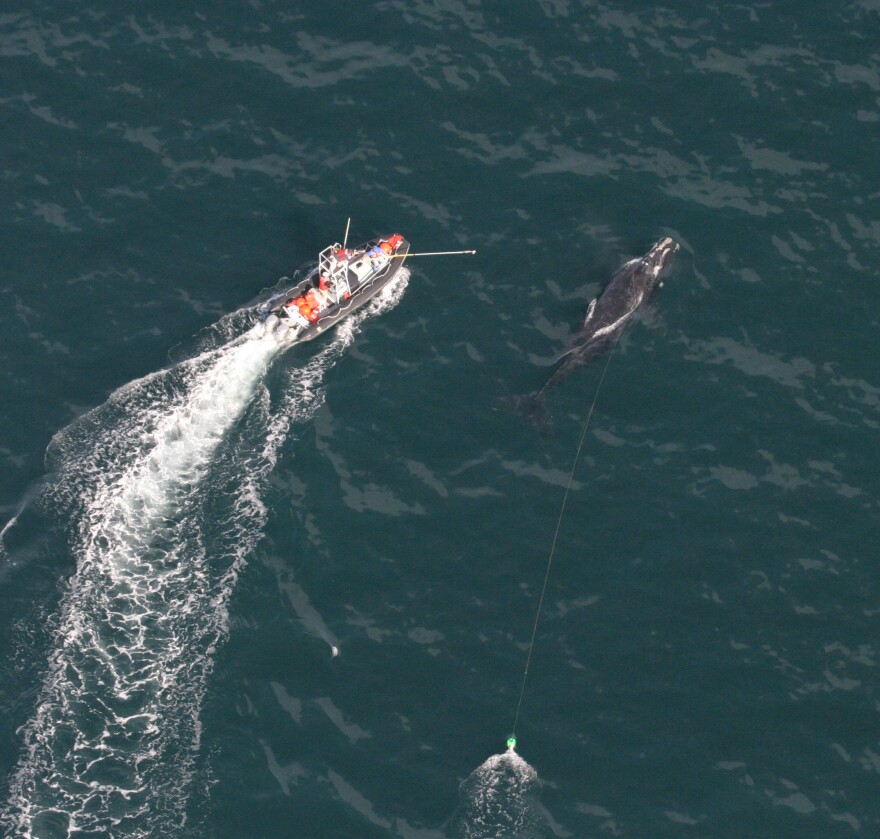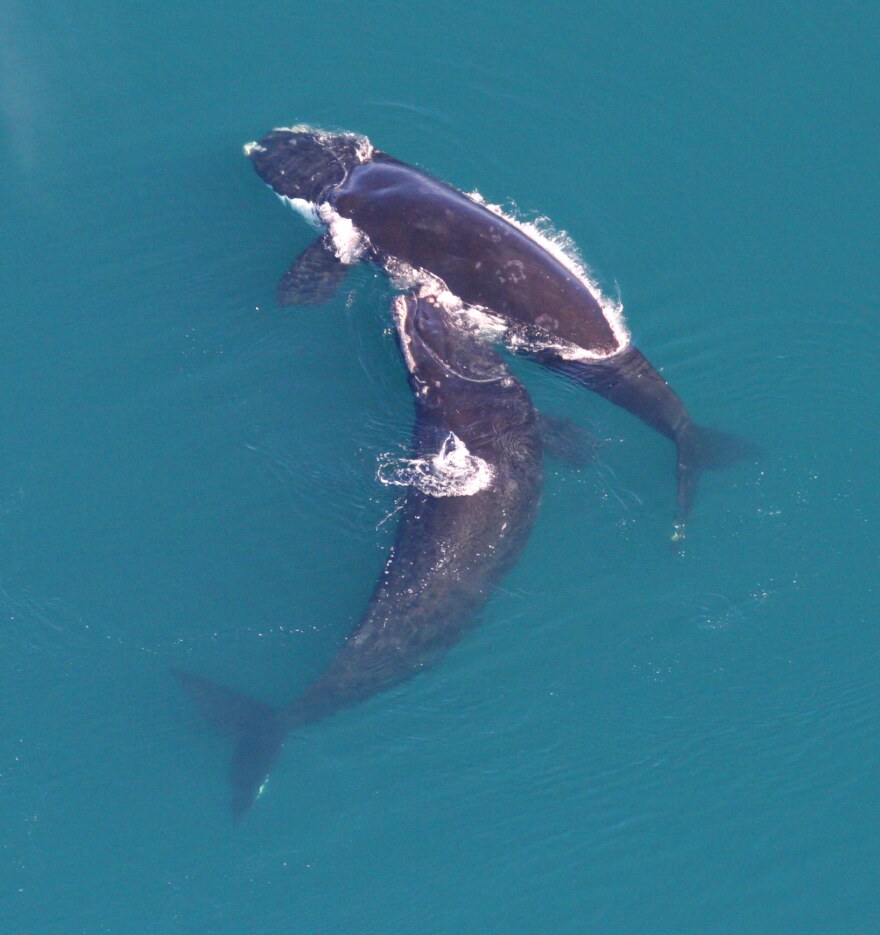The North Atlantic right whale is one of the most endangered whales in our coastal waters, and, while we are making progress in recovering this species, it still faces numerous threats. Studies over the past 20 years have increased our understanding of right whale ecology and habitat needs. Based on this research, the National Oceanic and Atmospheric Administration is proposing to expand the existing critical habitat areas. Sarah Finch has more.
North Atlantic Right Whales were once a preferred target for whalers. They migrate between feeding grounds in the Gulf of Maine and their winter calving areas off Georgia and Florida. University of North Carolina Wilmington Research Biologist William McLellan says they are called Right Whales, because historically they were the ‘Right’ whale to hunt.
“There is so much oil in their blubber that when they were killed they float and stayed at the surface so they could be towed to shore. The second reason they are called Right Whales is because they swam really close to shore, and in the earliest days they could actually be taken by shore-based whaling.”
At present, they are among the most endangered whales in the world, and are protected under two US laws: The Endangered Species Act and the Marine Mammal Protection Act. The right whale population is currently estimated at just under 500 animals, nowhere near where it should be, to be taken of the Endangered Species List.
“Right whale populations, they’ve been endangered for decades now. When I first started in the business in the 80’s there were about 250 North Atlantic Right whales. They were critically endangered. And then over time we started seeing more calves being born. The highest calving year we ever had was about 40 calves born off from the coast of Florida, Georgia, South Carolina, North Carolina.”
Under the Endangered Species Act, NOAA is required to designate Critical Habitat for all listed species. Critical habitat identifies geographic areas containing physical and biological features essential to the conservation of a specific animal.

The northern critical habitat provides foraging areas where the whales’ preferred prey, plankton are abundant. The southern habitat area includes features that support calving and nursing with optimal sea surface conditions, temperatures, and water depths. Coastal North Carolina is located in the middle.
Previously, right whale critical habitat was designated to include portions of Cape Cod Bay and other areas off the coast of Massachusetts, as well as the coastal waters of Georgia and Florida. Research Biologist McLellan describes this migration pattern as a seasonal event.
“Whales are summering up in the Bay of Fundy, all the way around through Nova Scotia, so the whales are all up there in the summer feeding. When they all come down, some of them, the pregnant females and the smaller animals, maybe even some of the adult males are coming south. So over the course of the year, we’re seeing right whales going through North Carolina waters on a regular basis.”
The Critical Habitat ruling being considered right now, addresses where right whales go to give birth. Florida up through to the Cape Fear region have good habitat for calving and nursing. Duke University Adjunct Professor, Caroline Good has been compiling data on this endangered species and their migration through the mid-Atlantic.
“They are not traveling northward in a straight shot, you know they are not just constantly moving likely. It’s very likely that what they are doing is sort of moving up and resting a bit, moving up and resting a bit. And the capes of North Carolina, Cape Fear and Cape Lookout, really provide a very nice shelter for mother-calf pairs.”
Based on this new information, the National Oceanic and Atmospheric Administration has proposed expanding the designated critical habitat to include more areas that will support whale calving. This NOAA rule would expand the critical habitat to include northeast feeding areas in the Gulf of Maine region and calving grounds from southeastern North Carolina to northern Florida. Research Biologist McLellan says this will expand the area from under 5 thousand square nautical miles to roughly 30 thousand.
As a member of the Atlantic Large Whale Take Reduction Team and the Southeast Implementation Team, Caroline Good, is conducting research that shows the migrating right whales prefer very specific habitat characteristics.

"One of the reasons that there has been an expansion of the critical habitat proposed for the southeast up into North Carolina is really a combination of two things. First of all there wasn’t much effort looking for right whales in South Carolina up into North Carolina. And there’s been increasing effort to actually locate where they are. And also all the work that’s gone into looking at the habitat needs, and requirements, and preferences of the whales has also uncovered that this is clearly an area that very much meets their criteria.”
The reason for the expanded protected area is to provide suitable, safe habitat as females travel south looking for waters that are fairly shallow, calm and cool. After giving birth, they’ll remain in the area for a few months, while the calf grows and becomes stronger. Calves are born 13–15 feet long and weigh approximately 3,000 pounds. While they are pretty functional immediately after birth, they still have to gain strength before they make the trip back up to New England.
“Essentially, when the calves are first born, they’re not particularly strong swimmers and they also have to surface very frequently, every minute and a half. Whereas an adult whale easily can hold its breath for over half an hour. And because of that, if you are in an area that has fairly calm water, and it’s not super choppy, it’s probably going to be much easier for that calf to surface, and not risk drowning potentially.”
It is possible that the mother might experience thermal stress and overheating if she is in water that is too warm. Because right whales have some of the thickest blubber of all the large whales, they actually seek out the cooler water. That’s why you don’t find right whales calving in the Caribbean.
In terms of their preference for a shallow habitat, Good believes that it may be an excellent way to avoid predation.
“So if you think of a whale sitting in the water, there’s essentially 5 ways they can be attacked, from below and then each of the four directions around them. But if they’re right up close to the shore, in shallow water, they can’t be attacked from below, which is a very common method by both orca and shark. On the shore side, they’re not going to be attacked from that side. So the mother is cutting off potential avenues of attack for the calf.”
The proposed rule does not include new restrictions or management measures for commercial fishing operations. Critical habitat designations do not create preserves, refuges or any other regulations directly affecting the public. NOAA Fisheries Greater Atlantic, Marine Mammal and Sea-Turtle Conservation Program Coordinator David Gouveia says based on their research, commercial fishing doesn’t have a direct impact on right whale critical habitat.

Designating critical habitat can affect federal agencies conducting, funding or permitting activities in those areas. They’ll be required to consult with NOAA Fisheries to evaluate whether and how their actions would affect the habitat. Gouveia says the goal is to avoid or reduce impacts to the North Atlantic right whales.
“Critical habitat is essential. So if there’s any other federally permitted activity, whether its dredging, whether its oil exploration, it gets viewed in a much more stringent light. Because that activity has to show that it does not have a detrimental impact to those primary and biological features that we’ve identified in those areas.
For these particular user groups, the new critical habitat rules provide extra attention to the survival of right whale species. Research Biologist McLellan predicts that it will make them more aware of the area and adjust their activities if needed.
“For instance the Navy has already agreed, anywhere there is right whale critical habitat, they are going to post extra watches, and they are going to take extra care.”
NOAA Fisheries representative Gouveia describes the animals white bumps.
“They have callosities that are all unique, so it’s like a fingerprint, so we are able to name certain animals, either a number or their name, such as Calvin.”
Here in North Carolina, we actually have a famous right whale named Calvin, who was unfortunately caught in fishing gear many years ago. NOAA Fisheries and the Atlantic Large Whale Take Reduction Team were able to locate and disentangled her, and she has been thriving ever since. Calvin has given birth twice that we know of near Wrightsville Beach, once in 2004 and again in 2008.
“We’re hoping that she’s really good luck. We know Calvin gave birth this year. She was actually seen off in Florida this year. So she’s still doing her job producing babies out there, so that’s great news.”
There are very few records of someone actually witnessing the birth of a right whale, so in some cases you see a pregnant mother, and then you see her later with a calf. Where exactly she gave birth to that calf, scientists are not yet certain. But looking at where mother-calf pairs are seen repeatedly, they are all over the Carolina coast come Spring.
The two primary human caused threats to Right Whales are collision from vessels and entanglement in fishing gear. As a Right Whale Necropsy Team Leader, McLellan has recently seen these threats decrease after NOAA established a set of recommended vessel routes and ship speeds.
“In 2008, there was a Speed Reduction Rule put in place on the East Coast, which slowed ships to 10 knots. Where up and down the coast seasonally, different ports would be closed at different times when there would be right whales offshore. Since 2008, we have seen zero ships strike Right Whales.”
A second major cause of mortality in the North Atlantic right whale is entanglement in fishing gear. According to McLellan, Right whales ingest plankton with wide-open mouths, risking entanglement in any rope or net fixed in the water column.
“In January of this year, there is an agreement now, to remove a whole lot of vertical line, specifically about 40% of the vertical line that’s in the water attached to pots and gear out there, to try to lessen that line that the animals will run into when they are swimming around with their mouths open.”
Some are able to escape, but others remain tangled unless they are rescued by specially trained crews. The National Marine Fisheries Service is responsible for the stewardship and management of living marine resources, which includes rescuing entangled right whales.

The majority of studies that are done to locate and identify right whales are through aerial surveys. Working from the Wilmington coastline, McLellan is usually the first to report the coordinates.
“So when we do get sightings, when we’re in the plane actually, we let the Coast Guard know immediately, on a frequency. And the Coast Guard will plot those up into the Whale Alert network.”
WhaleALERT is an app designed to give live up-to-date information about where right whales have been spotted. It’s part of an overall strategy to both educate and inform mariners, about the need to protect and be careful around these animals.
Ultimately, a new critical habitat designation must be supported by a full analysis of economic, national security, and other impacts. NOAA Fisheries is considering public comments before making a final decision on the Critical Habitat rule. For Public Radio East, I’m Sarah Finch.
For more information on the NOAA proposal, click http://www.nmfs.noaa.gov/mediacenter/2015/02/13_02_rightwhalecriticalhabitat.html
To comment on NOAA's proposed critical habitat expansion, click http://www.regulations.gov/#!docketDetail;D=NOAA-NMFS-2014-0085



